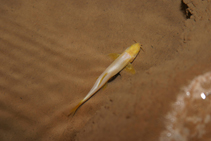http://www.fishbase.org/Summary/speciesSummary.php?genusname=Schistura&speciesname=oedipus ---> http://192.134.151.83/Summary/speciesSummary.php?genusname=Schistura&speciesname=oedipus
http://192.134.151.83/Summary/speciesSummary.php?genusname=Schistura&speciesname=oedipus ---> https://fishbase.mnhn.fr/Summary/speciesSummary.php?genusname=Schistura&speciesname=oedipus
https://fishbase.mnhn.fr/Summary/speciesSummary.php?genusname=Schistura&speciesname=oedipus ---> https://fishbase.mnhn.fr/summary/Schistura-oedipus.html
Schistura oedipus

You can
sponsor
this page
Common name (e.g. trout)
Genus + Species (e.g. Gadus morhua)
-

-
About this page
-
Languages
-
User feedbacks
-
Citation
-
Uploads
-
Related species
-


 Upload your
photos
and
videos
Upload your
photos
and
videos
Pictures
|
Google image
 Schistura oedipus
Schistura oedipus
Picture by
Panitvong, N.
Teleostei (teleosts) >
Cypriniformes
(Carps) >
Nemacheilidae
(Brook loaches)
Etymology:
Schistura:
Greek, schizein = to divide + Greek, oura = tail; an allusion to forked caudal fins (Ref.
45335
)
;
oedipus:
Specific epithet means a mythic Theban King who tore out his eyes (Ref.
39226
)
.
More on author:
Kottelat
.
Environment: milieu / climate zone / depth range / distribution range
Ecology
Freshwater; benthopelagic; depth range 0 - ? m (Ref.
42927
). Tropical; 20°N - 19°N
Asia: Thailand.
Size / Weight / Age
Maturity: L
m
?
range ? - ? cm
Max length : 5.4 cm SL male/unsexed; (Ref.
39226
)
Short description
Morphology
|
Morphometrics
Dorsal
soft rays
(total): 12;
Anal
soft rays
: 8. No color pattern; absence of externally visible eye but a pit in the center of the skin covering the orbit (Ref.
39226
). Retains some melanin pigmentation (Ref.
42927
).
Cave-restricted species (Ref.
12041
). Collected in a pool of moving water about 1 km from a cave entrance (Ref.
39226
). Mostly found stationary on the muddy bottom at depths from 20 cm to 1 m (Ref.
42927
). Tends to occur in slow moving water during the dry season, but some individuals were observed climbing rapids (Ref.
42927
). Small groups of individuals were frequently found in the pools while isolated individuals were common in rapids (Ref.
42927
). Weakly or not at all cryptobiotic, not remaining under rocks for more than 5 min during the day (Ref.
42927
). Feeds on insects and roundworms (Ref.
42927
). Shows behavioral responses to light, including avoidance and perhaps a residual diurnal rhythmicity (Ref.
42927
).
Life cycle and mating behavior
Maturity
|
Reproduction
|
Spawning
|
Eggs
|
Fecundity
|
Larvae
Kottelat, M.
, 1990. Indochinese nemacheilines. A revision of nemacheiline loaches (Pisces: Cypriniformes) of Thailand, Burma, Laos, Cambodia and southern Viet Nam. Verlag Dr. Friedrich Pfeil, München, Germany. 262 p. (Ref.
39226
)
IUCN Red List Status (Ref.
130435
)
Vulnerable (VU)
(D2); Date assessed:
25 February 2011
CITES
Not Evaluated
Not Evaluated
Threat to humans
Harmless
Human uses
Fisheries: of no interest
FAO - Publication:
search
|
FishSource
|
More information
Countries
FAO areas
Ecosystems
Occurrences
Introductions
Stocks
Ecology
Diet
Food items
Food consumption
Ration
Common names
Synonyms
Metabolism
Predators
Ecotoxicology
Reproduction
Maturity
Spawning
Spawning aggregation
Fecundity
Eggs
Egg development
Age/Size
Growth
Length-weight
Length-length
Length-frequencies
Morphometrics
Morphology
Larvae
Larval dynamics
Recruitment
Abundance
BRUVS
References
Aquaculture
Aquaculture profile
Strains
Genetics
Electrophoreses
Heritability
Diseases
Processing
Nutrients
Mass conversion
Collaborators
Pictures
Stamps, Coins Misc.
Sounds
Ciguatera
Speed
Swim. type
Gill area
Otoliths
Brains
Vision
Tools
Bio-Quiz
|
E-book
|
Field guide
|
Identification keys
|
Length-frequency wizard
|
Life-history tool
|
Point map
|
Classification Tree
|
Catch-MSY
|
Special reports
Check for Aquarium maintenance
|
Check for Species Fact Sheets
|
Check for Aquaculture Fact Sheets
Download XML
Summary page
|
Point data
|
Common names
|
Photos
Internet sources
AFORO (otoliths) |
Aquatic Commons
|
BHL
|
Cloffa
|
BOLDSystems
|
Websites from users
|
Check FishWatcher
|
CISTI
|
Catalog of Fishes
:
genus
,
species
|
DiscoverLife
|
ECOTOX
| FAO - Publication:
search
|
Faunafri
| Fishipedia |
Fishtrace
| GenBank:
genome
,
nucleotide
|
GloBI
|
Google Books
|
Google Scholar
|
Google
| IGFA World Record |
MitoFish
|
Otolith Atlas of Taiwan Fishes
|
PubMed
| Reef Life Survey | Socotra Atlas |
Tree of Life
| Wikipedia:
Go
,
Search
| World Records Freshwater Fishing |
Zoological Record
Estimates based on models
Phylogenetic diversity index (Ref.
82804
): PD
50
= 0.5000 [Uniqueness, from 0.5 = low to 2.0 = high].
Bayesian length-weight: a=0.00692 (0.00311 - 0.01538), b=3.02 (2.85 - 3.19), in cm total length, based on LWR estimates for this Genus-body shape (Ref.
93245
).
Trophic level (Ref.
69278
): 3.1 ±0.34 se; based on food items.
Resilience (Ref.
120179
): High, minimum population doubling time less than 15 months (Preliminary K or Fecundity.).
Fishing Vulnerability (Ref.
59153
): Low vulnerability (10 of 100).
Back to Search
Random Species
Back to Top
Accessed through:
Not available
FishBase mirror site :
localhost
Page last modified by :
mrius-barile
- 20 July 2016
Fatal error
: Uncaught ArgumentCountError: Too few arguments to function checkEcotox(), 1 passed in /var/www/html/summary/speciessummary.php on line 2304 and exactly 3 expected in /var/www/html/includes/speciessummary.lib.php:2579 Stack trace: #0 /var/www/html/summary/speciessummary.php(2304): checkEcotox() #1 {main} thrown in
/var/www/html/includes/speciessummary.lib.php
on line
2579
|